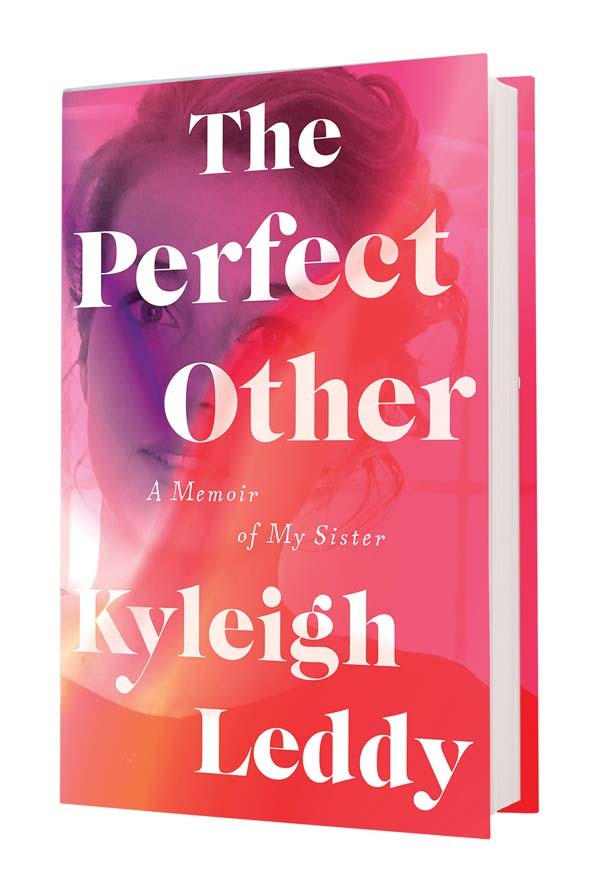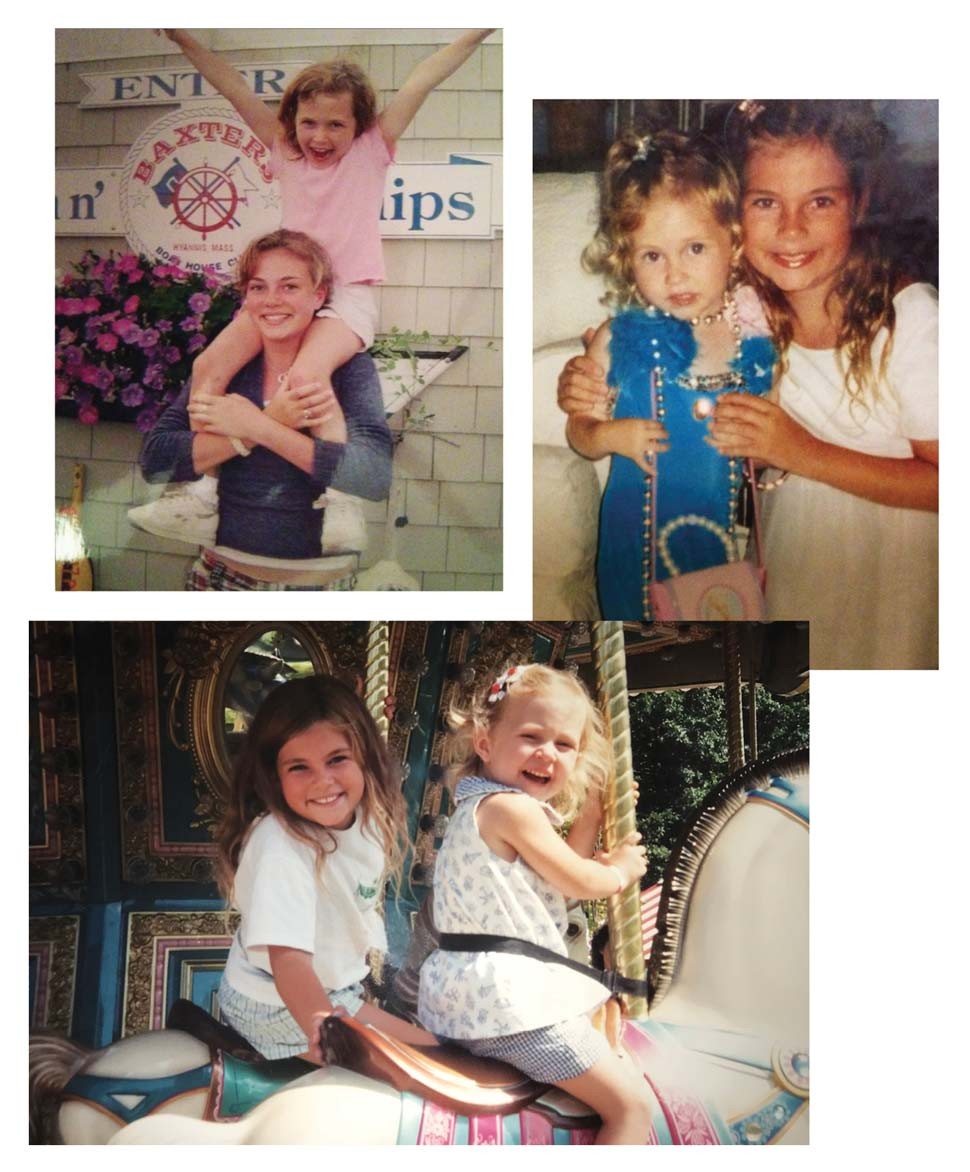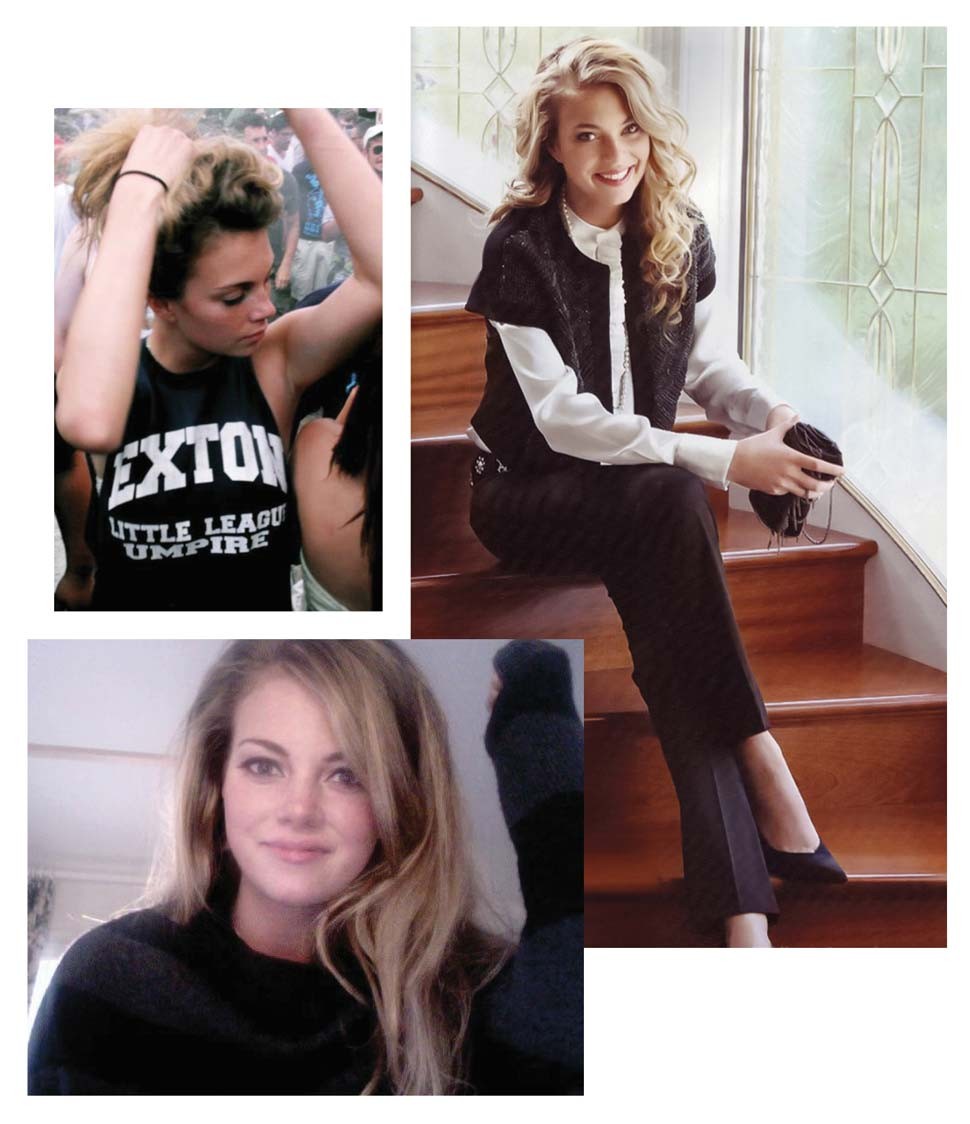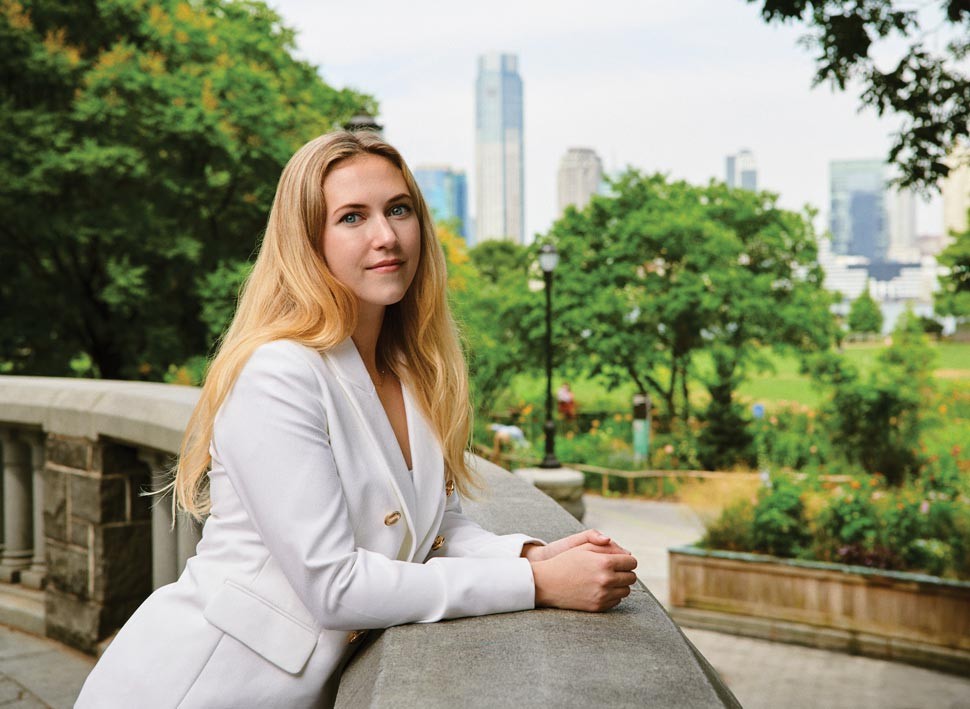Breathtaking
Gunnar Esiason's odyssey through cystic fibrosis and the American health care system.

Photographs by Jai Lennard
My Sister's Keeper
In her haunting book The Perfect Other: A Memoir of My Sister, Kyleigh Leddy ’19 recounts the fear, anguish, and heartbreak of losing a sister to mental illness.
“I know there are thousands, millions, billions of stories that my own will never touch. I also know that somewhere out there is a family suffering as ours did, voiceless and afraid,” Kyleigh Leddy ’19 writes in the introduction to The Perfect Other: A Memoir of My Sister, which was released earlier this year. The book tells the story of Leddy’s older sister, Kait, who went missing in 2014 after struggling with schizophrenia, and who has never been found. Leddy chronicles her journey through grief—first over Kait’s psychological decline and the loss of the sister she knew growing up in Massachusetts and Pennsylvania, and then over having to accept a tragedy that remains unresolved nearly a decade later.

Leddy begins by taking her readers through the years before she was even born. Kait, she would come to learn, prayed desperately for a little sister, desiring one in the way some children “want a puppy or the newest Barbie Dreamhouse.” Once Leddy came along, she and her sister formed a close bond. But their relationship became strained as Kait’s behavioral issues began to emerge when she was a young teen, escalating through high school. Later, while Kait was in college, an accident left her with a traumatic brain injury and psychological symptoms that were determined to be the result of schizophrenia. Then one night in January 2014, when Kait was twenty-two, she took a taxi to the Benjamin Franklin Bridge in Philadelphia. Surveillance cameras captured her walking to the bridge’s highest point, but nothing more. Her body has never been located.
The book started out as a composition that Leddy wrote during her senior year at BC for a “Modern Love” college essay contest in the New York Times. Leddy won the competition and soon heard from literary agents who believed her story had the makings of a powerful book. She began writing The Perfect Other in November 2019, not long after graduating from BC, and finished the book eight months later. During the nearly two years it took for The Perfect Other to be published, Leddy enrolled at Columbia University, from which she graduated this year with a masters in social work. She plans to one day author a second book about psychology. Her goal is to reduce the stigma around mental health. “I’m not grand enough to think that my book’s going to drastically change anything right away,” she said. “But I just hope people feel less alone.”
Following is an excerpt taken from The Perfect Other.
We moved to the city of Philadelphia in 2003, when I was entering first grade and my sister was going into the seventh grade. Our father was frequently away on business trips, designing and implementing fiber-optic networks in new countries and regions. It was the age of the dot-com bubble, between the late ’90s and early 2000s. People were using the internet with increasing frequency, and the stocks boomed with the flux. The opportunities came fast and didn’t stay long. If you blinked, you could miss it, so—as we’d done a few times before, and would do again later—when my father received a new job offer that he couldn’t resist, he and my mom seized the opportunity, packing us up and leaving Marblehead behind.
Our new home in Philly was a brick townhouse in a residential neighborhood of the bustling, winding downtown Center City. I was six, and I learned to do cartwheels on the rough sidewalks, avoiding the rubbery gray spots of melted gum, first with two arms, then with one. Kait or Mom would spot me, guiding my legs over my head and planting them firmly on the ground.
We attended the same Quaker school that year. I would search for Kait’s face in the crowd. The moment I spotted her, my chest surged with pride. That was my sister, I thought. That tall, beautiful girl, that’s my sister. When she or her friends waved at me, I felt I had done everything in the universe right. I liked life in the city, but Kait didn’t. We had moved four or so times before Marblehead, and for Kait, each new school was growing harder to keep up with. I was too young for any change to matter, too innocent for it to make an impression. My life was a tiny universe consisting of my immediate family, but Kait was older, more aware. She had to redefine herself in a sea of new faces with each move.

Clockwise from top left: Eight-year-old Kyleigh sits atop Kait’s shoulders outside a Cape Cod restaurant; playing dress-up together; having fun on a merry-go-round. Photos: Courtesy of Kyleigh Leddy
After all, how many times did my sister stand in front of a classroom and introduce herself to a room of strangers? How many times did she size up the students before her, decide who were the bullies and the victims, the mean girls and the boys who stuck pencils up their noses?
How many recesses did she stare at the asphalt and quickly scout out which of her classmates was the easiest to approach? Did it matter? At one school, was she one version of herself, and at the next, another? When the present unfolds like a slap, these are the questions you return to as prayer. What went wrong? Could we have stopped it?
I wish I could hug a younger version of myself and tell her that any perceived slight by Kait is unintentional: She was only trying to discover who she is. She was walking the first walk of adulthood with shaky legs, and she couldn’t have her little sister trailing after her wherever she went. I wish I could hug this younger version of Kait and tell her it’s all going to be okay, too. Tell her she’ll figure it out, grow into herself, become the person she’s meant to be, but then, wouldn’t that be a lie?
At thirteen, the cusp of adolescence, something was beginning to transform in my sister; a barely detectable ignition that sparked in the core of her being and snaked its way into every aspect of our lives. Even so, my big sister, the one who had so carefully cared for me throughout my childhood, was still there, at least sometimes.
That year, when my sister was thirteen, our mom was called into the principal’s office on more than one occasion to discuss her most recent spectacle. After a few months, we were ultimately asked to leave the school. My parents were already planning to eventually move to the suburbs, so that’s exactly what we did. It’s one of those moments you look upon in retrospect and see as a milestone in the story, a sudden break, the earth’s crust unsettling from its shelf. But at the time, my parents weren’t sure how seriously to take it. My father didn’t believe in therapy; still, they took my sister to a doctor just in case. The child psychologist evaluated her under careful scrutiny before proclaiming Kait a healthy and well-adjusted preteen. And like that, the question was resolved and we moved on. Any conversation around a diagnosis was dismissed.
On my seventh birthday, blowing out candles on a cake with frosting doled out in thick white waves before me, I made a wish that I would come to repeat every birthday until my seventeenth. “I wish my dreams come true, my family is healthy, and my sister gets better.”
“It’s surprising how misrepresented schizophrenia is in our culture. The condition is either sensationalized for dramatic effect—straitjackets, muzzles, blaringly white walls of psychiatric units—or it is somehow lightened, made a joke out of.”
Kait suffered from a traumatic brain injury and was diagnosed with schizophrenia when I was only twelve years old. The chaos, the violence, the heartache of that time slipped through my developing, adolescent brain. Here’s what I can recall: We pack bags. Mom and I shove emergency pajamas and overnight cosmetics—contact lenses for the morning, face wash, toothpaste—into hidden suitcases, tucked behind curtains, readily accessible in a rush. We memorize the closest exits, the quickest way out: Everywhere is a fire drill. When Kait is in between apartments, she stays at our family house and Mom prefers that I sleep in my parents’ room. There’s a balcony there. We could jump into the bushes if we needed to, if it got to that point. There’s comfort in this knowledge. When I sleep alone, I barricade my door with furniture; a chair or the bench at the end of my bed where my old American Girl Dolls are stored. The childhood objects weigh it down. In psychotic bursts, Kait makes threats. She’ll burn the house down in our sleep, she says. We believe her. She knows where the knives are, and she’ll whip them out. We take to hiding them. She thinks we’re trying to kill her, keep her captive. We’re out to get her. She’ll get to us first. All we can do is run. My sister hits my father in his sleep with a weight (there’s a photo of the bruise behind his ear, yellow and purple with inflammation). Kait throws pottery at us—expensive Italian Deruta our mom has been collecting piece by piece for years. There’s a photo of the trail of shattered pottery leading into our living room. In the background, you can see the teal of my rain boots. I thought Kait would appreciate the bright color, but she was too far gone by that point to ever notice.
When I was younger, twelve, thirteen, even fourteen, my mom would tell me to run into my bedroom and lock the door when Kait entered into a delusional breakdown, and I would listen. I used to grab our two dogs and usher them upstairs with me, locking the door behind us and leaning against the wooden frame for good measure. I held their shaking bodies as they sat in my lap. “Shush,” I tried to comfort them while petting their soft fur. “Everything is going to be okay.” Shush, I tried to tell myself, too, everything is going to be okay.
For a while, this worked. There seemed to be some limit Kait had drawn with me, holding me captive, making physical threats, throwing objects in my direction but never actually seriously harming me. Something stopped her every time from following through; some part of the older sister who once shielded me from the world now was shielding me from herself, from the battle being waged inside her brain. But as I grew older, I could no longer bear being away from my family in these moments of crisis. I needed to be there to protect my mom (in reality, there was little I could do to help, but it’s impossible to surrender even the falsest sense of control in these moments). I continued to hide the dogs, to keep them away from any danger, but hiding was no longer an option for myself, and the more I challenged my sister, the more in danger I became.

Clockwise from top left: Kait outside of a concert in her early twenties; in a 2010 modeling photo for Bergen County Magazine; posing for a selfie after a photoshoot. Photos: Courtesy of Kyleigh Leddy
Once she tried to push me off a balcony at a rental beach house we were staying at. Earlier that same day, she comforted me over my pubescent breakouts, letting me borrow some face wash and concealer. Now her hands reach toward me. She wraps her full hand around my wrists, squeezing them tight, holding me there as a prisoner with handcuffs of her own design. I try to fight back, but it’s useless. As much as I writhe and wiggle, I am trapped, powerless. I have never felt so impossibly small in this world. Mom distracts Kait by calling attention to herself long enough for me to escape. This is how we survive: taking turns in sacrifice, a game of diversion.
We escape in the middle of the night—in the morning, after school, before sports practice, at noon on an otherwise peaceful, quiet Sunday. The chaos has no bounds, no time frame, no workday hours. I grab my backpack, and I complete my homework in hotel rooms, in the public library, in the passenger seat of our car as we wait in a random empty parking lot. We eat a dinner of Chipotle in the front seat, but our stomachs never rest long enough to enjoy it. Mostly, we go to a small, unexciting hotel chain near our home and I study for my exams by the dingy light of the room’s meager desk.
We called the cops—for what, the fourth? fifth? sixth time that month?—our familial drama spewed onto the front lawn, an open-air show for our quiet neighborhood. There was a restraining order left unfilled on the counter of my kitchen. Our mom was too heartbroken to ever follow through with it, but the appearance of its yellow, punched frame frightens me: so permanent, bureaucratic and official, an intruder in our home.
I devote myself to academics, taking as many Honors and AP courses as I can find, forcefully flinging myself into some future I can’t imagine but hope is there when the smoke clears. I do everything you’re supposed to do—I laugh on cue, I go to the parties and the dances, the sports practices (lacrosse, tennis, squash, and crew) and the volunteer clubs, and I present myself the picture of ease. When the whole world is upside down, sometimes the sanest place is closest to the ground.
Kait developed multiple personalities, different versions of herself, and in their presence, I created my own. When the fighting escalates and I hide in my room, the miniature blue and yellow chair from my childhood blocking the door, or stand there and face my sister head-on, I try this coping mechanism: I think of my happiest memories with Kait, as if by concentrating hard enough I can cast the bad away, heal her from the inside out.
I think of us as little girls on the beach, the tide washing up clumps of thick seaweed the color of her eyes, the sand blowing in the breeze, picking up a wayward rope or an ocean-battered twig. I remember how we laughed that day in soft chimes, sharp yelps. Just as we already have everything inside us to hurt, so too do we have everything we need to redeem ourselves. I do my best to focus on the light.
“The doctor described my sister’s brain as a pinball machine: ‘Information goes in and then it bounces around and comes out different.’ I imagined a tiny metal ball banging against the edges of her brain tissue. An idea taking flight and then twisting unrecognizably.”
In the hours or days when her turmoil settled, Kait would come back to herself. On May 6, 2010, only a few months after her head injury when Kait’s schizophrenic symptoms were skyrocketing, she sent me the following message at 2:16 a.m.
I wish your face was little still so I could squeeze it and tell you that I will be the best sister in the entire world to you! I’m not nice to you I’m not fair to you I have so much happiness that I owe you! It’s all my fault, I never want you to see me again with the capital L on my forehead haha you’re perfect and you’re perfecting everything that I couldn’t!!! . . .
I act like a tough guy and I’m so sorry for being embarrassing . . . I sure hope I get to laugh at myself when I’m a little bit older.
Will you let me know what you want me to do to help you forgive me? I love you more than anything in this world you’re my life. . . .
If you have any questions or are confused ask me immediately because I’m just remembering who I am . . . and HATING who I’ve turned into! I’m promising this to you so we don’t have anything but the best loving relationship that we can . . . will you do that with your LOOPY sister? <3<3
She sent me the message immediately after one of her episodes, where she had screamed and threatened me. I remember opening the notification on my Facebook page, seeing the familiar lines of my sister’s name, feeling that flash of hope and love. And then, in the next moment, being unbelievably tired. Here was the vibrancy of her personality in her word choice (“loopy,” she said, as if to downplay the severity of the situation). Here was the sister I knew so well, the childhood protector, the silly playmate, but by this point I also knew too well that it was only a matter of minutes before she left me again. How could I allow myself the hope that today would be different, that this time she would stay?
This was Kait’s routine: After an episode, she would apologize. It was a near impossible apology to reject. Her face was a winning combination of demure regret—eyes cast down, delicate nose pointed toward the ground—and a slight tinge of mischief. The routine would follow with my sister leaving Post-it notes in my binders or textbooks, hidden between pages.
“I’m sorry,” I saw when I flipped the book open in class. Or, “You’re the prettiestttt ever!!!!” Some days even, “You’re the best little sistaaa in the world!!”
I crumpled the neon squares in anger and disbelief, throwing them in a trash can only to retrieve the paper and carefully smooth the edges, press it between heavy pages as if to preserve a dying flower.
What I’m trying to say is that sometimes Kait came back to herself. What I’m trying to say is that I wanted her to stay. She never did.

The doctor at Penn Medicine described my sister’s brain as a pinball machine. “Information goes in”—she motioned the movement of a ball entering the slot—“and then it bounces around a bit and comes out different.” I imagined a tiny metal ball banging against the edges of my sister’s soft brain tissue. An idea taking flight and then twisting unrecognizably.
During one of her stays home, Kait heard the noise of a nearby party. “They’re talking about me,” she told our mom, her eyes hurt and accusatory. “My friends are out there, and they’re all talking about me.” Her voice became angrier, frustrated.
“That’s just the sound of a party, Kait,” Mom said, trying to soothe her. “It’s not your friends. No one is talking about you.” Kait didn’t believe her. The noise of the party had entered her brain, bounced around, and emerged again as something different—perhaps her internal worries and fears collected at the edge of the sound, changing its form.
Kait could no longer distinguish between what was in her head and what was outside of it. But she was also aware of her own unsteadiness, aware she was no longer “normal.” Her friends were getting jobs, graduating from college. She was in and out of rehab centers and mental hospitals. She was falling behind, left on the sidelines, watching her classmates pass her by.
Our mom drove her around the neighborhood until they located the source of the noise, gesturing at the party to Kait through the car’s window. “See, it’s just strangers. Not your friends. They’re not talking about you.” Kait nodded, but there was no way to know if she really understood. 